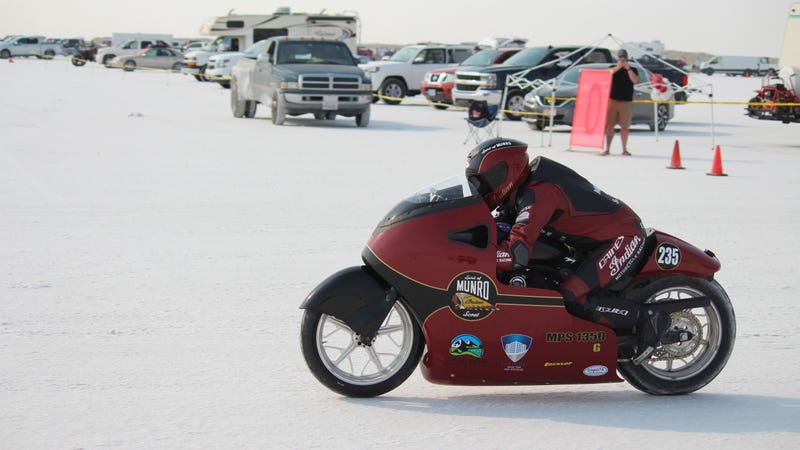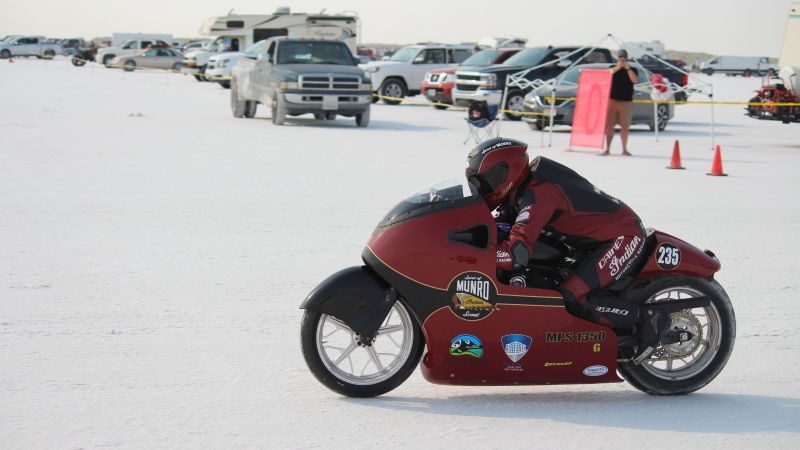
“The salt is good this year.” Seems like the kind of small talk you’d hear as expository in a sci-fi film, which is exacerbated by the fact that I’m standing on what looks like the face of an alien planet. Bonneville is its own small world, a microcosm of hot rods, motorcycles and burning nitromethane. For one week every year, it’s a place where speed heroes are born. Especially when the salt is good.
(Full Disclosure: Indian Motorcycles wanted me to come see its bike race at Bonneville so bad it invited me to the event. It also put me up in the nicest middle-of-nowhere casino hotel and kept me hydrated and fed so I didn’t die in the middle of the salt.)
During Speed Week, the Bonneville Salt Flats becomes home to hundreds of racers with their own dreams, goals, and top speeds. This isn’t a place many people casually visit; the speedway is their everything. These addicts live their life on the salt, and really only visit their jobs, family, and houses. One racer described the feeling of solitude at the end of a run as being better than sex.
Back in 1967, New Zealander Burt Munro famously raced his 1920 Indian motorcycle to an under 1000cc record at 184.08 MPH. Maybe you’ve seen the movie.
Advertisement
Last year, on the 50th anniversary of that record, another Munro mounted another Indian-built streamlined two-wheeler. Lee Munro, the circuit racing motorcycle racing nephew of Burt’s only son John, flew to the U.S. to ride a lightly fettled Indian Scout frame. He set a new class record on the bike at El Mirage, but fell well short of the high-rev sport bikes record—currently 223.237 MPH—at Bonneville, recording a high of 191 mph.
Munro, and the team at Indian, had developed some salt fever, and had to come back in 2018. The 50th anniversary had come and gone, but just like Munro’s great uncle Burt, this team was determined to keep chasing the dream of hitting 200 mph one way or another.
Advertisement
Built largely as a skunkworks project by the engineers from Indian’s parent company Polaris, this land speed effort was done on a minimal budget with a skeleton crew. Wayne Kolden is the point man on the project, and he’d been racing at Bonneville with some co-workers for a few years already. The 2017 effort was funded by the factory’s marketing budget, but there was really no plan to run a 51st anniversary effort. Munro tracked down a sponsor in New Zealand to fund the deal, and the Indian engineers threw together a last-minute arrangement with a stateside sponsor to make it work. 2018 was on.
The Indian Scout frame is unmodified for use in this semi-streamlined racer, though the bike’s rear suspension has been swapped out for a “hard tail” springless design, and the front fork has been narrowed with a custom triple tree to bring the shock tubes inward. For better aero prospects, the handle bars have been turned down at a 90-degree angle so Lee’s hands tuck within the off-the-shelf wind fairing. The engine uses the stock block, but the pistons have been enlarged, bringing the displacement from 1130cc up to 1299cc, and the cylinder heads have been modified to flow more air and cope with the higher revs. The stock engine makes an even 100 horsepower, but this racing version dyno’d at a little over 165.
Advertisement
After running at Bonneville in 2017, the bike was shipped off to motorcycle shows and events through the autumn and winter months. When it returned home, the bike was a little worse for wear, requiring some repairs to the fairing.
In the process of making it nice again, the Indian engineers, Kolden, Dan Gervais, and Cal Kirley, set to work modifying the aero slightly, fairing off the breakouts in the fiberglass shell where handlebars would generally go. They also developed a ram-air system for the bike’s airbox, fed by a pair of NACA-style ducts on the leading edge of the bike, hoping to provide some positive manifold pressure, and thus more power, at speed. Aside from that, the bike needed new tires, a new clutch, and a few minor trim bits.
Advertisement
Kolden and Kirley piled the bike, a handful of spares, and a few go-fast parts into a Mercedes tall-roof Sprinter and left the Polaris headquarters in Minnesota with Bonneville set in the nav. Basically, because the program was put together so last-minute, nobody had ridden the race bike since Lee’s run at Bonneville the year before. The team put the bike on a dyno and ran it through all the gears to make sure it was mechanically OK. Aside from that, Munro’s first run on Saturday, August 11 was his and the bike’s first in 51 weeks.
Much of Saturday morning was eaten up by the driver’s meeting, and by the time the bike was in line to make a run on the 5-mile short course, it was already 10:30 and the desert sun was blazing. The ambient air temperatures, mixed with the already less oxygenated air at elevation (Bonneville is over 4,000 feet above sea level), conspire to hinder the V-twin’s power output. In order to hit that 200 mark, they needed ideal conditions. That was already beyond possible for Saturday with temperatures reaching to 110 degrees, but the bike and Lee needed a familiarization run. He stepped up to the start line and pinned the throttle. Several minutes later we heard that he’d settled in at just over 160 MPH and everything felt fine.
Advertisement
Even better, the engineers were quite pleased to learn that their ram air system was working. The bike’s fuel tank has been moved to where the battery would normally go on a Scout, and the big black thing that looks like the stock fuel tank is actually the airbox for the engine. A small plug was fitted where the gas cap would normally sit, and was held in with some epoxy. At speed, the pressure was high enough that the plug popped off and smacked Lee’s helmet before falling down to the bottom of the fairing. With that kind of pressure, the engine should be making a bit better power, which hopefully translates to speed.
The course headwinds picked up later in the day, and the mercury continued to increase on the thermometer, so the team packed it in for the day and called it a successful first run. The salt was good, but with the winds gusting all week, the air would be the real enemy of speed.
Advertisement
Sunday arose bright and early for the lot of us, as the team wanted to get the bike ready for a run as soon as the course was open to take advantage of cooler temperatures and denser oxygen.
Lee was instructed to keep the bike in fifth gear to keep the powerband right where he needs it for max speed. When he returned to the pits, Lee said hanging out in fifth gear gave him some wheel spin at over 170 mph, so he shifted to sixth. In sixth gear at max rpm the best he could do was a 189.575 mph run. Not quite as fast as his run in 2017, before the good salt.
The team made plans for a second run later in the day with revised gearing, but while they were waiting in line to make a run that afternoon, a Camaro caught a cross wind and rolled several times, creating a garage sale of parts littered across the salt. The speedway officials halted all timing while the incident was cleared. The driver of the Camaro was carried off the flats in an ambulance and taken to Salt Lake City, but he came out of it OK.
Advertisement
I left Bonneville on Sunday, disappointed that I didn’t get to see the team make their goal. They stayed on an additional two days to further their attempts.
The Indian techs continued to make aerodynamic tweaks, test runs, and once again had to pause while pieces were picked up from another crash.
Advertisement
The minor aero changes on the bike between 2017 and 2018 have netted the team almost exactly one mph of improvement, as their best run came on Tuesday morning at 192.769. With optimal temperatures, gearing, near perfect salt, and wind at a minimum. “Bonneville’s the boss,” says team chief Kolden, conceding that they won’t reach their 200 mph goals.
The team is already planning on a return to the salt in 2019, and I’m trying to figure out how soon I can get back myself. I came home with some of that salt fever
Advertisement
As soon as I arrived home from the Salt Flats, I announced to my wife that this would prove to be the most expensive trip I’ve ever taken. I’ve officially dropped anchor in the salt, and one day I’m coming back. I’ve been a fan from the sidelines all my life. I enjoy motorsport immensely, but I’ve never been drawn to compete in any class or series until now. I must one day race a car of my own construction at Bonneville.
Advertisement
Advertisement















